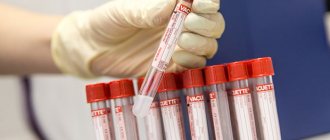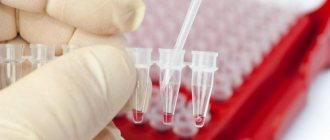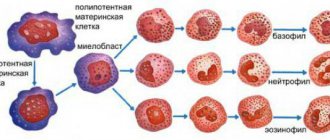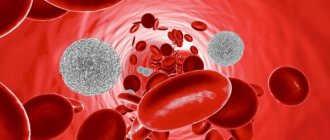Reasons for the decrease in the number of lymphocytes
The level of lymphocytes can not only increase, but also decrease.
Doctors call this condition lymphopenia. It can also be absolute and relative. The second variant of pathology is most common. Lymphopenia is a concomitant condition in a large number of diseases. The pathology does not have its own clinical picture. However, doctors identify a number of signs by which one can suspect it. So, first of all, the woman will feel a general deterioration in her health. Tests will show a decrease in the number of lymphocytes. Hypoplasia of the tonsils of the lymphopharyngeal ring is observed. There is underdevelopment of groups of lymphatic collectors. A decrease in the number of lymphocytes is observed when:
- anemia;
- leukemia;
- initial stages of infectious diseases;
- hereditary immunodeficiency diseases;
- oncological pathologies;
- the effects of radiation and chemotherapy.
Causes of low white blood cell count
A low white blood cell count is called leukopenia. With a lack of white blood cells, the body becomes more vulnerable to various pathological processes. A dangerous condition is if the deficiency of leukocytes is caused by disturbances in the functioning of the bone marrow, where these cells are synthesized. The manifestations of such a pathology will affect the functioning of the entire body - there will be a hormonal imbalance, metabolic disorders, and failure of other organs and systems.
Serious pathologies are also autoimmune disorders, in which the body’s own cells are perceived as foreign and are destroyed by antibodies. Such conditions are very difficult to treat and remain with a person for life.
Leukopenia can also occur when there is a lack of nutrients that are needed to create white blood cells. These include folic acid, B vitamins and others. Against the background of this condition, a decrease in the level of other blood cells is also diagnosed.
When a patient experiences leukopenia, this becomes noticeable in her general health. Weakness, chronic fatigue, decreased resistance to infections, and symptoms of intoxication (which are not suppressed by leukocytes) appear.
Leukopenia can occur for the following reasons:
- increased activity of the spleen, which leads to excessive death of white blood cells;
- specific bacterial infections;
- viral infections, including influenza and hepatitis;
- autoimmune pathologies, in which one’s own antibodies kill white blood cells;
- diseases of the thyroid gland, in which hypothyroidism is observed;
- anemia, in which the total number of all blood cells decreases;
- poisoning with chemical compounds, which leads to suppression of red bone marrow activity;
- exhaustion of the body, including starvation and dystrophy;
- radiation sickness affecting the blood-forming organs;
- taking certain medications that have leukopenia as a side effect.
A change in the white blood cell count in any direction is abnormal. If an increase in their number, in most cases, indicates an intensified fight of the body against the pathogen, then a decrease in the number indicates a deterioration in the body’s defenses. With leukopenia, a secondary infection is often observed, which is usually severe.
A decrease in the number of neutrophils is often observed in specific infectious diseases, for example, tuberculosis, typhoid fever, as well as anemia and anaphylactic shock.
A decrease in the lymphocyte count is characteristic of immunodeficiency states and acute inflammatory processes. A temporary decrease may be observed after X-ray examination.
A decrease in the number of monocytes can be caused by malignant blood diseases, biogenic infections and aplastic anemia. These diseases are quite serious and threaten the patient's life.
A decrease in the number of eosinophils is observed at the very beginning of the inflammatory process. In addition, a similar symptom is observed with heavy metal poisoning or with a purulent infection.
Basophils can decrease in the blood even for natural reasons, for example, during ovulation, stress or pregnancy.
What to do in case of deviations?
The sequence of actions when identifying abnormalities in the neutrophil count is determined by a doctor who has an idea of the health status of a particular woman. It is highly not recommended to independently attempt to influence the concentration of active components.
Ways to increase neutrophil levels
To increase the level of neutrophils, in the vast majority of cases, doctors prescribe:
- adjust your diet, focusing on foods enriched with vitamin C, E, B, zinc, omega 3;
- taking narrow-acting medications, for example, Neuprogen;
- wash your hands regularly with antibacterial products;
- avoid contact with sick people;
- Clean your mouth daily to minimize the burden on your immune system.
Decreased neutrophil levels
The following may help reduce neutrophil levels:
- eliminating the root cause of the jump in the indicator (for example, eliminating pathogenic microflora using antibacterial drugs);
- refusal to consume animal products;
- normalization of the emotional state (to quickly resolve psychological problems, it is recommended to consult a psychologist).
The norm of neutrophils is determined by the woman’s health status, her age, as well as psychological stability. By making a harmonious lifestyle, a person in some cases manages to normalize the concentration level of the main blood components, thereby minimizing the risk of developing life-threatening diseases.
Article design: Oleg Lozinsky
Functions of neutrophils
These cells solve a large group of specific tasks facing the human body’s defenses:
Release of bactericidal substances
The structures of cytological units contain specialized compounds that have the ability to kill pathogenic flora. When a target is detected, the neutrophil releases a substance that dissolves the cell membranes of the pathogen.
Thus, the genetic material is not encapsulated and the bacterium dies. This is one of the main mechanisms of neutrophil activity.
Antigen binding
The cells in question on the membranes have special receptors for specific immunoglobulins of class G; they are the most common in the body and are highly active in the fight against infectious agents of all types.
Due to the ability to bind such substances, neutrophils can quickly transport them to the site of injury to enhance the immune response. Thus, the destruction of pathogens is achieved much faster.
Direct absorption of microorganisms
Formed cells are capable of phagocytosis. They are large and aggressive enough to destroy bacteria by “eating” them. On average, a neutrophil can eliminate up to 20-30 foreign structures using different methods. Which indicates its high efficiency.
Inhibition and inactivation of viral agents
White blood cells have the ability to reduce the rate of replication of foreign pathogens and reduce the productivity of their existence. In favorable cases, complete suppression of the structures is achieved, due to which the inflammatory processes disappear.
The functions of neutrophils ultimately come down to one thing - the destruction of bacteria, viruses, fungi, and other objects in various ways. Therefore, an increase in the Neut indicator in a blood test indicates an immune response, be it a reaction to an infectious lesion or allergic processes. Next, you need to understand it in detail, in essence.
If segmented neutrophils are increased
The growth of cells of the neutrophil species is called neutrophilosis. The level of segmented neutrophils exceeds 75%.
Both segmented and rod cells increase.
Sometimes earlier forms appear in a blood test - myelocytes, but segmented ones do not change. In the leukocyte formula, this looks like a shift to the left (according to the location of cells in the list of leukocyte forms). At the same time, granularity is detected in neutrophils.
The causes of neutrophilia can be:
- infection with acute bacterial, fungal infection, spirochetes;
- exacerbation of the inflammatory process in rheumatism, pancreatitis, polyarthritis;
- the presence of a dead area in the body, for example, in acute myocardial infarction;
- recent vaccination;
- severe alcohol intoxication;
- disintegrating tumor;
- damage to the kidney tissue, especially with diabetic nephropathy;
- treatment with steroid hormones, heparin.
Vaccination of the adult population is carried out according to epidemic indications.
A shift to the right is detected when a high level of segmented forms predominates over younger band forms. It's possible:
- Segmented neutrophils are increased in the child’s blood and nasal smear. Reasons what to do
- after acute blood loss;
- as a reaction to blood transfusion;
- for some types of anemia.
The cause of a temporary increase in neutrophils may be:
- condition before menstruation in women;
- long-term stress associated with increased workload;
- physical stress.
Pregnancy causes a general increase in white blood cells by 20%. This is the protection of the mother and fetus from unwanted influences. During pregnancy, the absolute number of segmented neutrophils is increased (more than 6 x 109/l), and their relative level in the formula remains unchanged.
To determine the severity of the disease, neutrophilia is divided into forms:
- moderate - the number of cells is not higher than 10 x 109/l;
- pronounced - absolute content from 10 to 20 x 109/l;
- severe - cell count above 20 x 109/l.
Methods of correction and prevention
Special nutrition and some herbal infusions help increase the level of leukocytes. Correction of lymphocyte levels is especially necessary for those who have undergone chemotherapy, since after it the function of bone marrow hematopoiesis is impaired.
Beans, red caviar, beet juice and pomegranate increase the level of lymphocytes. Fats of animal origin must be limited during the recovery period - the body spends more energy on their digestion than on digesting cereals.
Infusion of dry sweet clover, plantain juice and pollen, which must be mixed with honey before use, are very helpful in the treatment of leukopenia.
Leukopenia in a woman at any age is a dangerous condition in which the defenses are weakened. To prevent immunodeficiency, which accompanies a decrease in the level of leukocytes, medications are prescribed that help improve hematopoietic function.
Steroids are prescribed to treat leukocytosis caused by inflammation. Severe cases are treated with leukapheresis.
Increased neutrophil levels
An increase in the level of neutrophils does not always require drug treatment, however, if there are visible deviations in test results, doctors strongly recommend undergoing an additional examination of the body’s condition in order to identify the causes of such changes.
Causes
The most common causes of increased neutrophil concentrations include:
- pregnancy (2nd trimester);
- inflammatory kidney diseases;
- pathologies of the venous system of the body;
- inflammation of the vermiform appendage of the cecum (appendix);
- diseases of the female reproductive system;
- pathologies of the skeletal system;
- damage to the mucous membranes of the female body;
- acute inflammatory processes of the respiratory organs;
- deviations from the normal state of the cardiovascular system;
- pathologies of the brain and spinal cord;
- cirrhosis of the liver;
- gout;
- oncological diseases in advanced forms.
Despite the large number of diseases, the signs of which are a jump in the level of neutrophils in a woman’s body, the most common reasons for such changes are non-dangerous (provided measures are taken in time to eliminate them) circumstances.
For example:
- eating large amounts of heavy food on a regular basis;
- prolonged depression or severe stress suffered on the eve of the test;
- recovery period after surgery;
- strength training and a large amount of physical activity;
- a tendency to exhibit allergic reactions (or a reaction that occurs at the time of taking a blood test).
Degrees of neutrophilia
Neutrophilia is the process of changing the concentration of neutrophils in a woman’s blood by more than 6.5 * 109 per 1 liter of blood.
It comes in three types:
- moderate (the number of neutrophil cells in 1 liter of blood reaches 10 billion);
- pronounced (the number of neutrophil cells in 1 liter of blood reaches 10 - 20 billion);
- severe (the number of neutrophil cells in 1 liter of blood reaches 20 - 60 billion).
Based on the degree of neutrophilia, doctors determine the severity of the progressive disease, as well as the current stage of its development. With extensive damage to the body, the number of neutrophils is as high as possible, and neutrophilia is advanced.
When the pathology in question is identified, drug treatment is prescribed only after the doctor is convinced that there are no secondary circumstances, the presence of which allows us to consider this process a variant of the norm.
Neutrophilia as a normal variant
In women carrying a child, neutrophilia may be a variant of the norm (if the number of leukocytes of the type in question is up to 10 billion in 1 liter of blood).
In addition to pregnancy, high neutrophil levels can be affected by:
- eating heavy food before taking the test (for example, if a woman donates blood in the morning, and in the evening her dinner consisted of a fatty steak and a high-calorie side dish);
- excessive emotional stress (not necessarily at the time of the test. The indicators can be affected by stress suffered by a person the day before, for example, 3-4 weeks before the test);
- excessive physical activity the day before (before donating blood to determine the level of neutrophils, it is recommended to minimize physical activity and not go to the gym both on the day of the test and the day before it).
In these circumstances, adjustment of neutrophil levels with drug therapy is not necessary.
Reasons for the increase in some cells and the decrease in others
An increase or decrease in neutrophil levels in the blood can be correlated with many factors of natural and pathological origin. There are many uniform elements that are called upon to fight “strangers” in this case. There are two options:
- if neutrophils are elevated, and lymphocytes, on the contrary, this is the first phase of the immune reaction, when central immunity is not yet active enough, and there is no need for it: fluctuations are insignificant;
- if neutrophils are reduced, and lymphocytes, on the contrary, this is the second phase of the immune response, when central cells work more actively, and local-level structures reduce their intensity for a short time.
The general rule is one: when neutrophils increase, lymphocytes decrease and vice versa. This is the norm. There is no simultaneous increase or decrease observed.
Norm of segmented and band neutrophils
Neutrophils make up the bulk of granulocytes (granular white blood cells). The norm of segmented and band neutrophils in the blood is an indicator that reflects the state of the immune system at a particular point in time and indicates the possible presence of any infectious diseases in the body.
Neutrophils are a type of leukocyte, among which there are two main subtypes: segmented (mature), which make up the bulk of leukocytes, and band (immature), which are the precursors of segmented ones. Their main function is the destruction of foreign hostile microorganisms (bacteria) that enter the human body. Neutrophils are produced by the bone marrow and are able to migrate from blood vessels to other tissues and organs affected by the inflammatory process.
The share of neutrophils accounts for 50-70% of the total number of all leukocytes, the share of band neutrophils (young cells) - 1-5% of the total number of neutrophils. However, when the immune system is mobilized in the event of a bacterial attack, the number of immature cells in the peripheral blood can increase by an order of magnitude.
In absolute terms, the normal number of neutrophils in the blood is 1.7-8 g/liter, the total number of leukocytes is 4-9 g/liter.
The norm of neutrophils in the blood of children varies depending on age and is usually indicated in relative terms (percentage). This norm for children and adults is as follows:
| Child's age | Segmented neutrophils, % | Band neutrophils, % |
| Newborns | 47 – 70 | 3 – 12 |
| Up to 2 weeks | 30 – 50 | 0,5 – 4 |
| From 2 weeks to 1 year | 15 – 45 | 0,5 – 4 |
| From 1 to 2 years | 25 – 48 | 1 – 5 |
| From 2 to 5 years | 32 – 55 | 1 – 5 |
| From 6 to 7 years | 35 – 58 | 1 – 5 |
| From 8 to 9 years old | 41 – 60 | 1 – 5 |
| From 9 to 11 years old | 43 – 60 | 1 – 5 |
| From 12 to 15 years | 45 – 60 | 1 – 6 |
| Adults | 50 – 70 | 2 – 6 |
As children grow, the percentage of neutrophils in the blood increases, although their absolute value remains virtually unchanged. At the age of 2 to 5 years, the norm of segmented cells can reach a maximum, then their indicators decrease again and reach the norm of an adult by 12-15 years. Since a child’s immunity has not yet been fully formed until the age of 3, a moderately low level of neutrophils may also be a variant of the norm.
As for adults, the norm of band and segmented neutrophils in the blood of women is identical to those of men.
To determine their number, a general detailed blood test is taken, the results of which contain information about all types of neutrophils. To calculate the absolute number of neutrophils of a certain type, you need to multiply the relative indicator by the total number of leukocytes. If, say, neutrophils are 68%, leukocytes are 5 g/liter, then the absolute number of neutrophils: 5 × 0.68 = 3.4 g/liter.
A reduced level of neutrophils in the blood is called neutropenia, an increased level of neutrophils is called neutrophilosis. One of the most common causes of both pathological conditions are acute infections and inflammatory reactions of bacterial and fungal origin.
In case of serious health problems, immature forms of neutrophils (myelocytes and promyelocytes), which are normally found only in the bone marrow, enter the bloodstream.
Thus, minor deviations of neutrophils from the norm may be temporary and a sign of mobilization of the immune system, but serious deviations in indicators over a long period of time require a comprehensive examination.
No comments yet
Pathological causes of growth
The norm of neutrophils in the blood changes in most cases due to pathological reasons, the main of which are:
- inflammation of infectious or autoimmune origin;
- endocrine pathologies;
- tumor growth, metastasis;
- physician error during surgery (iatrogenic factor).
There is an exception to the rule: neutrophils can remain normal against the background of a manifest pathological process, which indicates depletion of the immune system and requires immediate adequate treatment.
Indicators below normal values
Neutrophils (the norm in women’s blood should be assessed taking into account the results of previous studies), when they are insufficient in the female body, weaken the immune system without preventing the proliferation of bacteria and fungi.
Causes
The concentration of neutrophils, significantly lower than normal, indicates the presence of neutropenia in the female body.
Most often it occurs due to:
- excessive amounts of pathogenic microorganisms;
- depletion of the circulatory system;
- inability to produce the required number of neutrophils due to external circumstances;
- serious blood diseases;
- bacterial lesions of the female body;
- viral diseases (identified by an increase in the number of lymphocytes and monocytes along with a decrease in the concentration of neutrophils);
- individual reactions of the body to drug therapy (for example, taking immunomodulators, interferon);
- radioactive exposure;
- carrying out chemotherapy or radiation treatment for cancer patients;
- leukemia;
- low level of hemoglobin in the blood;
- vitamin deficiency (lack of folic acid and B vitamins can especially affect the level of neutrophils).
Degrees of neutropenia
Neutropenia, depending on the reasons that provoked its occurrence, can be of three types:
- soft (the number of neutrophil cells in 1 liter of blood ranges from 1 to 1.5 billion)
- moderate (the number of neutrophil cells in 1 liter of blood ranges from 0.5 to 1 billion);
- severe (the number of neutrophil cells in 1 liter of blood does not reach 0.5 billion or the type of leukocyte in question is completely absent).
When diagnosing neutropenia, doctors usually monitor the trend of changes in the woman’s blood test results, since a single decrease in neutrophils cannot be regarded as a pathological condition requiring medical intervention.
Particular situations of neutropenia
In three cases, neutropenia can be considered normal and not provoke the need for additional examination of the woman’s health status.
For example:
- a physiological feature of the body, or benign neutropenia (diagnosed in the absence of deviations of other indicators from the norm);
- cyclic neutropenia (implies a cyclic variation (a cycle can range from 2 weeks to 3 months) in the level of the type of leukocyte in question - from minimal values to normal without drug intervention in the process);
- Kostman's neutropenia (a genetic disease that causes a complete absence of neutrophils in the body. If a person with this feature managed to survive the first year after birth, over the following years his body adapts to the circumstances, producing monocytes and eosinophils in sufficient quantities to compensate for the lack of neutrophils).
Special cases of decreased neutrophils
We are talking about genetically determined neutropenia, which is quite rare, but affects the result of a blood test. This:
- benign chronic neutropenia is asymptomatic, there is no danger to life, but when interpreting the analysis, this point is always taken into account;
- cyclic neutropenia occurs in one person per million, does not affect the quality of life, manifests itself in a periodic causeless decrease and then restoration of neutrophils to normal;
- Kostmann's syndrome is a condition when neutrophils are deprived of the opportunity to mature, as a result a person is deprived of natural protection and constantly suffers from all possible infections. Today, provided that the pathology is detected in a timely manner, patients are given courses of drug correction.
Why are leukocytes needed?
Leukocytes are white blood cells. There are several types of them in the human body, all of them are designed to fight pathogens and perform a protective function.
When an infection or allergen enters the body, leukocytes immediately react and are sent to the source, where they quickly eliminate the cause by digesting and absorbing foreign particles. Leukocytes are able to pass through the capillary wall and effectively penetrate into the intercellular space.
When such pathological processes appear in the body, the number of leukocytes increases sharply, which becomes a diagnostic sign and is easily detected based on the results of laboratory tests. Leukocytes take part both in stopping the infectious process and in inflammatory reactions.
The swelling and redness that occurs during infectious diseases are caused by increased migration of leukocytes to the lesion. After the pathogen has been defeated, the white blood cells are also destroyed and accumulate to form pus. Every person has seen an accumulation of leukocytes in the form of wound suppuration, yellow-green mucus in the respiratory tract, or thick green nasal discharge. Leukocytes are produced in smaller quantities than red blood cells. Their normal amount varies from 4-9*109/l.
Moreover, the number of leukocytes may vary slightly during the day, even in a healthy body. This indicator depends on the functional state, physical and mental health of the woman. In pathological situations, the number of leukocytes can change both towards a decrease and towards an increase in the normal number.
In addition, some physiological changes in the number of leukocytes are allowed. In men, the number of white blood cells is almost stable, but in women it undergoes some fluctuations. This is explained by additional stress due to hormonal changes, menstruation and other factors.
There are several types of leukocytes, each of which performs its own functions. By assessing the qualitative and quantitative ratio of all types, more information can be obtained than by counting the total number of white blood cells. To do this, it is recommended to do a detailed clinical blood test, which will show the leukocyte formula.
Neutrophils - what are they?
Neutrophils play a very important role in human immunity, removing and destroying microorganisms, unnecessary metabolic products, foreign substances, damaged and malfunctioning cells. Neutrophils perform these functions by the method of phagocytosis, that is, by the method of absorbing and eating these substances.
Neutrophils also participate in a very necessary process for the body called proteolysis, which breaks down proteins into their component parts . This is done by adding water to protein molecules. It is worth noting that proteins are very complex substances that consist mainly of amino acids necessary for the renewal and functioning of the human body.
Neutrophils are produced primarily in the bone marrow, which fills cavities in the bones. Once the white blood cells are sufficiently formed, they leave the bone tissue and travel through the blood circulation. Here they are usually divided into two types - segmented and band leukocytes. When they say that a neutrophil is mature, this means that its development has reached its greatest point. This cell goes through several stages in its development:
What does a general blood test show during pregnancy? 34528
- Myeloblast.
- Promyelocyte.
- Myelocyte.
- Metamyelocyte.
- Band forms.
- Segmented, mature form.
The main characteristic of a mature neutrophil is that its nucleus (central structure) is divided into 3-5 sections called nuclei, which do not exist separately, but are connected together by thin threads called chromatin. Under the magnification of a strong microscope, these nuclei are clearly visible.
Decreased lymphocytes
A low level of lymphocytes may indicate the development of a number of diseases or pathological conditions or be an individual characteristic of a person. This condition is called lymphocytopenia or lymphopenia.
In medical practice, two types of disease are distinguished:
- Relative lymphopenia (the percentage of lymphocytes among all leukocytes decreases, while their number may remain unchanged). Lymphocytes die very quickly, which leads to disturbances in the development of the lymphatic system. Occurs as a result of acute or chronic infectious diseases.
- Absolute lymphopenia (the number of lymphocytes decreases). It manifests itself against the background of congenital or acquired deficiency of the body’s immune forces. It appears in patients with neutrophilia, leukemia, leukocytosis, and also as a result of exposure to radiation.
Reduced lymphocytes can signal the development of a number of diseases
Causes
The standard lymphocyte count of 20-40% for an adult can fall for various reasons. There are quite a lot of them, and therefore it can be difficult to make a correct diagnosis. Only anamnesis and additional diagnostic methods will allow you to determine the disease more accurately.
Among the most common causes of lymphopenia are:
- AIDS;
- various chronic liver lesions;
- a blood disease in which all bone marrow sprouts are inhibited - aplastic anemia;
- pathologies of a purulent and septic nature;
- severe infectious diseases;
- acute miliary tuberculosis (often confused with typhoid fever);
- treatment through chemotherapy and radiation therapy;
- destruction of lymphocytes (can occur with certain diseases, for example, lupus erythematosus, or as a result of taking certain groups of drugs - corticosteroids, cytostatics, etc.);
- disorders of the immune system of a congenital nature;
- renal failure;
- lymphogranulomatosis;
- Itsenko-Cushing syndrome;
- splenomegaly;
- cancer in the lymphatic system;
- infectious and purulent-inflammatory diseases in acute form (abscess, sore throat, influenza, pneumonia, etc.).
Diseases and conditions that provoke lymphopenia are often classified as severe and dangerous to the body and have a poor prognosis. Therefore, if a blood test shows low lymphocytes for a long time, this is a signal that a thorough medical examination should be carried out.
Low level of lymphocytes in the child's blood
In a child, lymphopenia does not have any noticeable clinical symptoms. But against the background of cellular immunodeficiency, parents may observe the following signs:
- eczema, purulent skin lesions;
- focal baldness – alopecia;
- pale or yellow skin;
- hemorrhagic spots on the skin.
Clinical diagnosis will also reveal significant shrinkage of the lymph nodes and tonsils and splenomegaly (enlarged spleen).
When there is a low level of lymphocytes in a child’s blood, relapses of infectious diseases become more frequent. Often their causative agents are rare strains of microorganisms.
Possible symptoms
As in children, adults have virtually no obvious symptoms of lymphopenia. Among the manifestations encountered are the following:
- increased body temperature;
- general weakness;
- fast fatiguability;
- hair loss.
The symptoms described above are also typical for adults: reduction of lymph nodes, pale skin and purulent lesions, eczema, enlarged spleen. If you notice one or more of these signs, you should consult a doctor to undergo a full diagnosis and determine treatment methods.
Treatment of lymphopenia
Lymphopenia itself cannot be corrected. Treatment of the primary disease will be required to restore normal lymphocyte levels. When a diagnosis of chronic lymphocytopenia is made, immunoglobulin will need to be injected into the body. Low lymphocyte counts due to congenital immunodeficiency can be corrected by stem cell transplantation.
If standard diagnostics do not allow identifying the disease that caused lymphopenia, then the hematologist can refer the patient for additional studies: MRI/CT, ultrasound, cytological and histological tests, x-rays, etc.
Eosinophils
| Eosinophils - This type of leukocytes is the main “orderly” of the body. It is these cells that neutralize many toxins and allergens. They limit the spread of infectious agents and participate in the formation of humoral immunity. | |
| Age | Index |
| 1-3 days | 1 — 6 % |
| 4 – 14 days | 1 — 6 % |
| from 2 weeks to 12 months | 1 — 5 % |
| from 1 to 2 years | 1 — 7 % |
| from 2 to 5 years | 1 — 6 % |
| from 6 to 7 years | 1 — 5 % |
| from 8 to 9 years | 1 — 5 % |
| from 9 to 11 years | 1 — 5 % |
| from 12 to 15 years | 1 — 5 % |
| Over 16 years old | 1 — 5 % |
- Allergies of any kind
- Parasitoses (giardiasis, ascariasis, enterobiasis, opisthorchiasis, echinococcosis)
- Chronic infectious and inflammatory diseases (scarlet fever, tuberculosis, mononucleosis,
- Sexually transmitted diseases
- Malignant neoplasms
- Blood diseases (leukemia, lymphoma, lymphogranulomatosis)
- Autoimmune diseases (rheumatoid arthritis, periarteritis nodosa, scleroderma)
Why are eosinophils reduced?
- Heavy metal intoxication
- Purulent processes - abscess, phlegmon, gangrene, osteomyelitis
- Beginning of an infectious disease
Types of leukocytes, leukocyte formula
There are five types of leukocytes, which are found in the body in a certain ratio. This ratio is called the leukocyte formula, and any changes in its indicators can be a diagnostic sign of disease. The following types of leukocytes are distinguished:
- Neutrophils. The main function is to destroy bacterial infection.
- Lymphocytes. Responsible for general immunity and immune memory, stimulate the production of antibodies.
- Monocytes absorb particles of foreign agents and stimulate their own immunity.
- Eosinophils. They fight mainly against allergens that have entered the blood.
- Basophils. The phagocytic function is insufficient, but basophils help limit the source of inflammation and the spread of infection.
Leukocytes are able to penetrate deep into absolutely all tissues. They are the ones who make up the immune response after the penetration of pathogenic microorganisms, the growth of atypical neoplasms, and the entry of foreign particles into organs.
Migrating to the site of inflammation, leukocytes absorb and digest the pathogen. They produce substances that help destroy atypical cells or even their own if there is a virus inside them.
Basophils contain platelet adhesive factors, which help them fight conditions that are accompanied by bleeding. The number of white blood cells can be influenced by various factors: age, time of day, food intake and exercise, heat, menstrual bleeding, medications.
A normal leukocyte formula involves taking into account all types of leukocytes as a percentage. The total number of cells is always 100%. The formula looks like this:
If one of the parameters changes, it entails a change in the other parameter. From this, doctors draw conclusions about which processes in the body predominate and what diagnosis to make.
The leukocyte formula helps to monitor the dynamics of the disease. In many pathological processes, changes in the formula will be similar, so the results of the leukocyte formula themselves do not mean anything; they should be assessed only in conjunction with the patient’s complaints and clinical symptoms.
The formula is written in a certain order - from young forms of leukocytes to more mature ones. When one indicator changes at the expense of another, this is called a shift in the leukocyte formula to the left or to the right.
When the number of young forms increases, the formula is said to be shifted to the left. This condition usually indicates inflammation, necrotic processes, infectious diseases, and intoxication. In this case, sometimes a temporary imbalance occurs, for example, during heavy physical activity. In this case, the white blood cell ratio will return to normal on its own.
When the leukocyte formula shifts to the right, mature forms of leukocytes will predominate in the blood. This ratio often indicates radiation sickness, problems with the liver and kidneys, and a lack of vitamin B12.
Segmented neutrophils are increased
If neutrophils in the blood are elevated, what does this mean and what is the reason – doctors cannot immediately answer for sure. The only correct statement is the presence of an infection, a pathology complicated by the penetration of pathogenic microbes into the body. In order to accurately establish a reliable cause, a thorough, comprehensive examination of the entire body is required.
However, in most cases, increased segmented neutrophils in the blood are recorded when:
- development of bacterial infection;
- the appearance of a fungal infection;
- mild inflammatory process.
Segmented neutrophils are increased - reasons
An increase in segmented neutrophils is always a reason to examine the body. In such cases, they speak of a shift in the leukocyte formula to the right.
Among the common situations accompanied by this symptomatology, it is necessary to highlight:
- Not related to pathology: physical activity, food intake.
- Pathological: purulent abscesses, burns, trophic ulcers, leukemia, acute inflammatory diseases (pneumonia, tonsillitis, otitis, sepsis, peritonitis), the formation of malignant or benign tumors.
Segmented neutrophils are increased - what to do?
The main task in this case is to determine the reason why increased segmented neutrophils are detected.
The patient is indicated for additional examination, including consultations with the following specialists:
- therapist;
- infectious disease specialist;
- hematologist.
The patient must strictly follow the doctor's instructions and prescriptions. If neutrophilia is caused by a certain pathology, therapy is aimed at its complete cure.
- Reduced neutrophils in the blood
To help your body recover faster, doctors recommend following the following rules:
- Rejection of bad habits.
- Healthy eating.
- Seasonal therapy using multivitamins.











